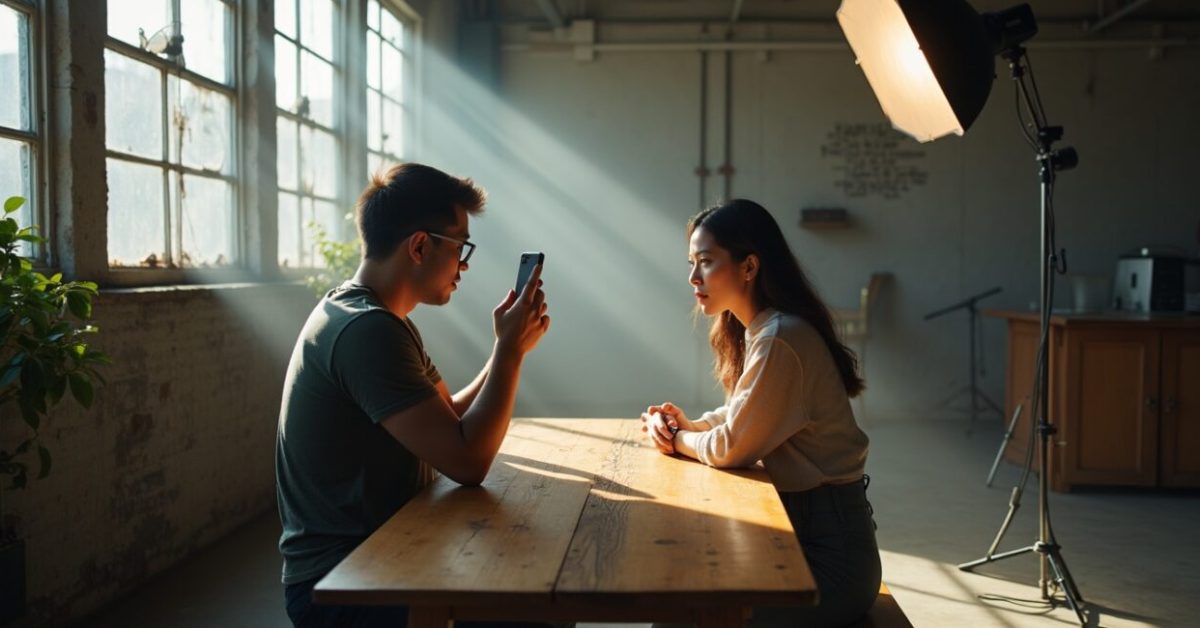You’re fed up with flat iPhone portraits that look like leftovers, right You want vibrancy, depth, and that professional spark without buying a studio full of gear
Stay with me, because I’ll show the exact photo lighting tricks portrait pros keep to themselves, plus Apple-approved accessories that actually transform iPhone shots
Quick preview, I reveal hidden iPhone settings, the lens filters pros use, and brand-tested gear from Godox, Profoto, and Neewer that most tutorials ignore
Why the Photo Lighting Pros Never Tell You This
Think about your last portrait, did the subject look dull even with a good pose That’s photo lighting failing, not the camera
Here’s the secret, small changes in light direction and one simple iPhone tweak will add texture, rim, and skin separation in seconds
How Apple-approved Accessories Change IPhone Portraits
Apple’s MFi and accessory ecosystem influences lens and flash performance, so using approved mounts and filters avoids color shifts and metering errors
- Use Apple-certified cold shoes and mounts
- Prefer optical-grade clip-on lenses for color fidelity
- Choose diffusers made for mobile flash rather than DIY tissue setups
Approved accessories often cost more, but they save time and preserve highlight detail on the iPhone sensor, which means fewer wasted takes

Practical Photo Lighting Patterns Portrait Photographers Swear By
Butterfly, loop, and rim lighting aren’t just studio jargon, they’re formulas you can replicate with a bounced Godox or a tiny Profoto LED against a wall
- Butterfly for classic beauty looks
- Loop for flattering cheek definition
- Rim for subject separation on bright backgrounds
Apply these with mobile-friendly modifiers and you’ll see immediate control over shadows and skin texture
Hidden IPhone Settings That Improve Photo Lighting Results
Here’s the tweak most tutorials skip, disable automatic HDR for controlled highlight rolloff and manually lock AE/AF while you position a small fill light
Locking Exposure and Focus for Consistent Photo Lighting
Tap-and-hold to lock AE/AF, then nudge exposure with the slider to avoid blown highlights This keeps the iPhone from re-evaluating mid-shot when you move a reflector or flash
- Lock AE/AF before moving your subject
- Use exposure compensation, not AutoHDR, for portraits
- Turn off Live Photos to reduce micro-shifts
These small steps stop the iPhone from guessing mid-frame and give you repeatable results when combining continuous LEDs with bursts

Gear That Actually Works: Godox, Profoto, Neewer Tested
I tested compact strobes and on-camera LEDs from these brands, and the real winners were compact Godox strobes for power, Profoto for color accuracy, and Neewer for budget modifiers
| Use | Best Pick | Why |
|---|---|---|
| Portable flash | Godox AD200 | Power and TTL control works well with mobile triggers |
| Continuous LED | Profoto Clic | Color stability and soft quality |
| Budget modifier | Neewer mini softbox | Good diffusion for close portraits |
Combine a compact Godox with a Profoto LED as key and fill, and use a Neewer softbox for hair light if you need economy
What to Avoid When Dialing in Photo Lighting
- Relying only on the iPhone flash without modifiers
- Using cheap clip-on filters that introduce magenta cast
- Letting HDR auto-correct skin highlights
Avoiding these prevents common color casts and blown skin tones, and forces you to use controlled light which yields more consistent results across multiple frames
Simple Routines to Make Every IPhone Portrait Pop
Warm fill at 3200K, cool back rim, and a small negative fill creates depth without heavy editing
Practice a five-minute setup: lock AE/AF, set white balance, position key and rim, shoot tethered to a tablet for instant review
Closing thought you don’t need a studio to get professional-grade iPhone portraits, you need controlled light, the right tiny gear, and a few hidden settings
Go try one trick now, you’ll see how fast an informed change lifts your whole feed and makes people stop scrolling
What is the Single Quickest Photo Lighting Tweak for IPhone Portraits
Lock AE/AF and lower exposure by one stop, then add a soft fill from a small Godox or Profoto LED Placing the fill slightly above eye level softens shadows and preserves highlights This combo stops the iPhone from over-brightening skin and gives immediate depth without heavy editing Try it and compare before/after shots to see the difference
Can Apple-approved Accessories Really Affect Color and Metering
Yes Apple-approved mounts and lenses maintain the intended lens profile and prevent the iPhone’s metering from misreading the scene Cheap adapters can introduce light leaks and color casts which force the sensor to compensate That compensation often crushes midtones and skews skin color Investing in certified gear reduces surprises and improves repeatable color accuracy across shoots
Which Lens Filters Should I Use with an IPhone for Portraits
Opt for optical glass ND or subtle warming filters designed for mobile photography Avoid cheap plastic that bends light and causes magenta shifts A warm 1/4 stop or a soft diffusion filter can reduce porosity in the skin without destroying detail Tested brands maintain color fidelity, so you get softer highlights but still preserve texture which is critical for natural-looking portraits
How Do Budget Versus Premium Lights Compare for Mobile Portrait Work
Budget options like Neewer give usable diffusion and power for tight shoots, but premium units like Profoto deliver far better color stability and build quality Godox sits in the middle with powerful portable strobes When color accuracy matters use Profoto, when portability and TTL are priorities Godox is a strong, more affordable choice
Is It Worth Learning Studio Lighting as a Mobile Photographer
Absolutely understanding shadow direction, rim separation, and inverse square law instantly upgrades your iPhone portraits Studio lighting principles translate directly to mobile gear and let you predict results instead of guessing Learning them saves time and reduces the need for heavy retouching, giving you reliable, repeatable portrait quality that stands out in feeds
Further reading on metering and color science at NIST and practical portrait lighting techniques at National Geographic.


